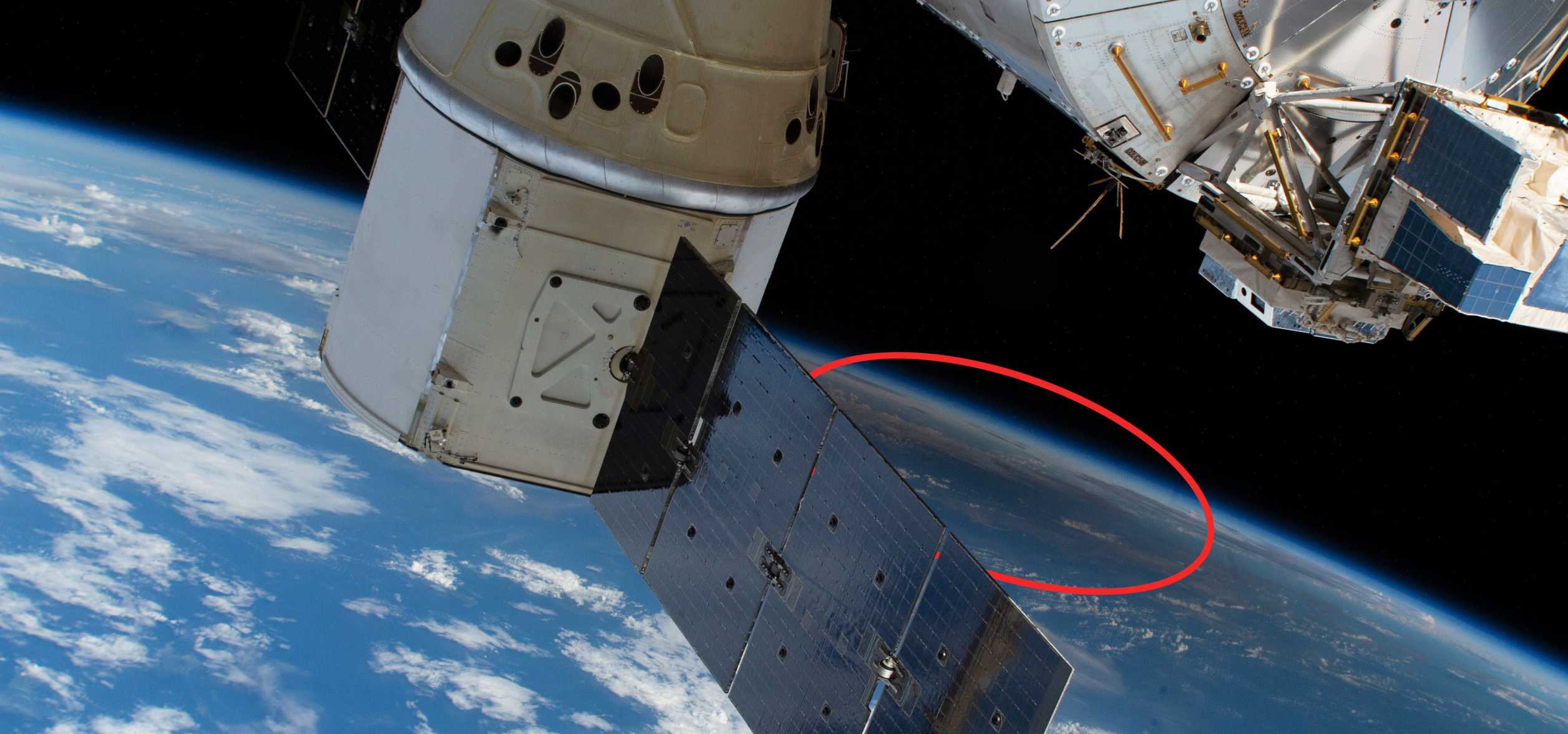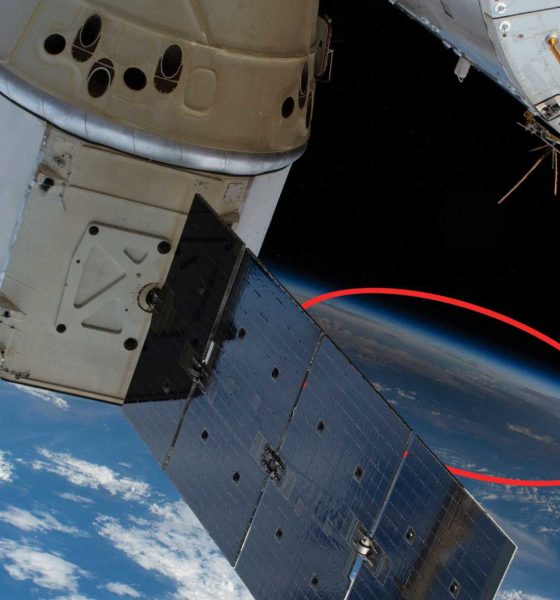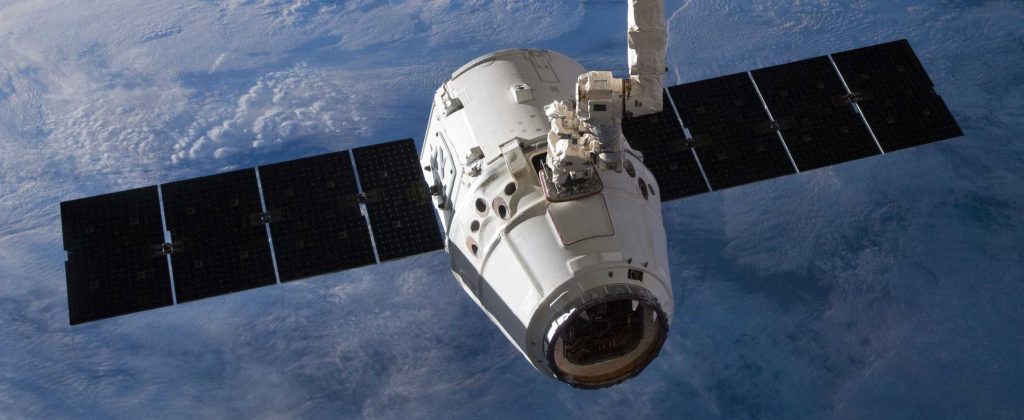

News
SpaceX's Dragon spacecraft photobombed in orbit by solar eclipse
On December 26th, SpaceX’s second-to-last Cargo Dragon spacecraft was photobombed in orbit by the shadow cast on Earth by a solar eclipse, likely a little over a week before the vehicle is set to reenter the atmosphere and splash down in the Pacific Ocean.
Cargo Dragon lifted off atop a rare new Falcon 9 booster – B1059 – on December 5th, carrying around 2600 kg (5800 lb) of cargo inside on the flight-proven capsules third launch into Earth orbit. After a quick three-day journey from its parking orbit to the International Space Station (ISS), Dragon was successfully captured by the station’s astronauts with a robotic arm and berthed to the orbital outpost, where the crew quickly unloaded its cargo of food, consumables, science, and equipment.
Shortly after liftoff, Falcon 9 B1059 completed its first successful landing – a bit of a surprise ordeal aboard drone ship Of Course I Still Love You (OCISLY) – and the relatively gentle reentry and trajectory should mean that the booster can be turned around almost immediately for its next launch. B1059 is thus a prime candidate for reuse on a future NASA mission and could very well support Cargo Dragon’s next space station resupply mission (CRS-20) as early as March 2020.
For a number of reasons, the spacecraft’s recent success is a touch bittersweet.
Notably, CRS-19 is the second to last orbital mission scheduled for SpaceX’s original Dragon spacecraft, which debuted in orbit in December 2010, becoming the first commercial spacecraft to successfully reenter and be recovered intact. Less than a year and a half later, Cargo Dragon became the world’s first commercial spacecraft to successful rendezvous and berth with the International Space Station (ISS).
The rest, as they say, is history. Five months later, SpaceX launched Cargo Dragon’s first official mission under NASA’s Commercial Resupply Services (CRS) program, known as CRS-1. Aside from a June 2015 launch vehicle failure that prevented Cargo Dragon from reaching orbit on its CRS-7 mission, SpaceX has successfully completed every resupply mission that managed to reach orbit, delivering more than 43 metric tons (95,000 lb) of supplies to the space station and the astronauts aboard it.

There have been several technical challenges over the years but every Cargo Dragon that reached orbit successfully completed its space station resupply mission and was recovered intact from the ocean surface after reentering Earth’s atmosphere. SpaceX has matured and improved almost every aspect of the spacecraft over the nine years it’s been flying, substantially upgrading its PICA-X heat shield, improving navigation sensors, upgrading its reusability, testing Crew Dragon and Starship hardware, and more.
Cargo Dragon has without a doubt been one of SpaceX’s biggest successes, combining with the company’s exceptionally capable and affordable Falcon 9 rocket to enable reliable cargo resupply missions, while also continuing to be the only way that NASA (or anyone alse) can return substantial non-human payloads back to Earth. Thankfully, although the spacecraft’s exceptional track record is set to come to an end after its next launch, the Cargo Dragon lineage will continue to supply the space station in the form of a modified version of Crew Dragon (i.e. Dragon 2).
On December 26th, SpaceX’s CRS-19 Cargo Dragon – attached to the International Space Station (ISS) – was photobombed by the shadow produced on Earth’s surface by an annular solar eclipse. With any luck, the spacecraft’s first upgraded successor will take over and begin orbital resupply launches as early as August 2020, setting SpaceX up for at least another four or so years of Dragon launches.
Check out Teslarati’s Marketplace! We offer Tesla accessories, including for the Tesla Cybertruck and Tesla Model 3.

News
Tesla FSD Supervised wins MotorTrend’s Best Driver Assistance Award
The decision marks a notable reversal for the publication from prior years, with judges citing major real-world improvements that pushed Tesla’s latest FSD software ahead of every competing ADAS system.

Tesla’s Full Self-Driving (Supervised) system has been named the best driver-assistance technology on the market, earning top honors at the 2026 MotorTrend Best Tech Awards.
The decision marks a notable reversal for the publication from prior years, with judges citing major real-world improvements that pushed Tesla’s latest FSD software ahead of every competing ADAS system. And it wasn’t even close.
MotorTrend reverses course
MotorTrend awarded Tesla FSD (Supervised) its 2026 Best Tech Driver Assistance title after extensive testing of the latest v14 software. The publication acknowledged that it had previously criticized earlier versions of FSD for erratic behavior and near-miss incidents, ultimately favoring rivals such as GM’s Super Cruise in earlier evaluations.
According to MotorTrend, the newest iteration of FSD resolved many of those shortcomings. Testers said v14 showed far smoother behavior in complex urban scenarios, including unprotected left turns, traffic circles, emergency vehicles, and dense city streets. While the system still requires constant driver supervision, judges concluded that no other advanced driver-assistance system currently matches its breadth of capability.
Unlike rival systems that rely on combinations of cameras, radar, lidar, and mapped highways, Tesla’s FSD operates using a camera-only approach and is capable of driving on city streets, rural roads, and freeways. MotorTrend stated that pure utility, the ability to handle nearly all road types, ultimately separated FSD from competitors like Ford BlueCruise, GM Super Cruise, and BMW’s Highway Assistant.
High cost and high capability
MotorTrend also addressed FSD’s pricing, which remains significantly higher than rival systems. Tesla currently charges $8,000 for a one-time purchase or $99 per month for a subscription, compared with far lower upfront and subscription costs from other automakers. The publication noted that the premium is justified given FSD’s unmatched scope and continuous software evolution.
Safety remained a central focus of the evaluation. While testers reported collision-free operation over thousands of miles, they noted ongoing concerns around FSD’s configurable driving modes, including options that allow aggressive driving and speeds beyond posted limits. MotorTrend emphasized that, like all Level 2 systems, FSD still depends on a fully attentive human driver at all times.
Despite those caveats, the publication concluded that Tesla’s rapid software progress fundamentally reshaped the competitive landscape. For drivers seeking the most capable hands-on driver-assistance system available today, MotorTrend concluded Tesla FSD (Supervised) now stands alone at the top.
News
Elon Musk’s Grokipedia surges to 5.6M articles, almost 79% of English Wikipedia
The explosive growth marks a major milestone for the AI-powered online encyclopedia, which was launched by Elon Musk’s xAI just months ago.

Elon Musk’s Grokipedia has grown to an impressive 5,615,201 articles as of today, closing in on 79% of the English Wikipedia’s current total of 7,119,376 articles.
The explosive growth marks a major milestone for the AI-powered online encyclopedia, which was launched by Elon Musk’s xAI just months ago. Needless to say, it would only be a matter of time before Grokipedia exceeds English Wikipedia in sheer volume.
Grokipedia’s rapid growth
xAI’s vision for Grokipedia emphasizes neutrality, while Grok’s reasoning capabilities allow for fast drafting and fact-checking. When Elon Musk announced the initiative in late September 2025, he noted that Grokipedia would be an improvement to Wikipedia because it would be designed to avoid bias.
At the time, Musk noted that Grokipedia “is a necessary step towards the xAI goal of understanding the Universe.”
Grokipedia was launched in late October, and while xAI was careful to list it only as Version 0.1 at the time, the online encyclopedia immediately earned praise. Wikipedia co-founder Larry Sanger highlighted the project’s innovative approach, noting how it leverages AI to fill knowledge gaps and enable rapid updates. Netizens also observed how Grokipedia tends to present articles in a more objective manner compared to Wikipedia, which is edited by humans.
Elon Musk’s ambitious plans
With 5,615,201 total articles, Grokipedia has now grown to almost 79% of English Wikipedia’s article base. This is incredibly quick, though Grokipedia remains text-only for now. xAI, for its part, has now updated the online encyclopedia’s iteration to v0.2.
Elon Musk has shared bold ideas for Grokipedia, including sending a record of the entire knowledge base to space as part of xAI’s mission to preserve and expand human understanding. At some point, Musk stated that Grokipedia will be renamed to Encyclopedia Galactica, and it will be sent to the cosmos.
“When Grokipedia is good enough (long way to go), we will change the name to Encyclopedia Galactica. It will be an open source distillation of all knowledge, including audio, images and video. Join xAI to help build the sci-fi version of the Library of Alexandria!” Musk wrote, adding in a later post that “Copies will be etched in stone and sent to the Moon, Mars and beyond. This time, it will not be lost.”
News
Tesla Model 3 becomes Netherlands’ best-selling used EV in 2025
More than one in ten second-hand electric cars sold in the country last year was a Tesla Model 3.

The Tesla Model 3 became the most popular used electric car in the Netherlands in 2025, cementing its dominance well beyond the country’s new-car market.
After years at the top of Dutch EV sales charts, the Model 3 now leads the country’s second-hand EV market by a wide margin, as record used-car purchases pushed electric vehicles further into the mainstream.
Model 3 takes a commanding lead
The Netherlands recorded more than 2.1 million used car sales last year, the highest level on record. Of those, roughly 4.8%, or about 102,000 vehicles, were electric. Within that growing segment, the Tesla Model 3 stood far ahead of its competitors.
In 2025 alone, 11,338 used Model 3s changed hands, giving the car an 11.1% share of the country’s entire used EV market. That means more than one in ten second-hand electric cars sold in the country last year was a Tesla Model 3, Auto Week Netherlands reported. The scale of its lead is striking: the gap between the Model 3 and the second-place finisher, the Volkswagen ID3, is more than 6,700 vehicles.
Rivals trail as residual values shape rankings
The Volkswagen ID.3 ranked a distant second, with 4,595 used units sold and a 4.5% market share. Close behind was the Audi e-tron, which placed third with 4,236 registrations. As noted by Auto Week Netherlands, relatively low residual values likely boosted the e-tron’s appeal in the used market, despite its higher original price.
Other strong performers included the Kia Niro, the Tesla Model Y, and the Hyundai Kona, highlighting continued demand for compact and midsize electric vehicles with proven range and reliability. No other model, however, came close to matching the Model 3’s scale or market presence.








